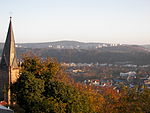Max Planck Institute for Terrestrial Microbiology
BiogeochemistryGenetics in GermanyMax Planck InstitutesMicrobiology institutes

The Max Planck Institute for Terrestrial Microbiology (German: Max-Planck-Institut für terrestrische Mikrobiologie) is a research institute for terrestrial microbiology in Marburg, Germany. It was founded in 1991 by Rudolf K. Thauer and is one of 80 institutes in the Max Planck Society (Max-Planck-Gesellschaft). Its sister institute is the Max Planck Institute for Marine Microbiology, which was founded a year later in 1992 in Bremen.
Excerpt from the Wikipedia article Max Planck Institute for Terrestrial Microbiology (License: CC BY-SA 3.0, Authors, Images).Max Planck Institute for Terrestrial Microbiology
Alte Straße nach Kirchhain,
Geographical coordinates (GPS) Address Website Nearby Places Show on map
Geographical coordinates (GPS)
| Latitude | Longitude |
|---|---|
| N 50.806388888889 ° | E 8.8108333333333 ° |
Address
Philipps-Universität Marburg - Campus Lahnberge
Alte Straße nach Kirchhain
35043 , Ortenberg
Hesse, Germany
Open on Google Maps










